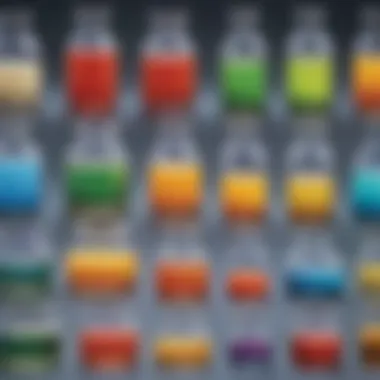Exploring Viscosity: Experiments and Insights


Intro
Viscosity is a fundamental property of fluids that affects how they move and behave. Understanding viscosity not only sheds light on scientific principles but also has wide-ranging practical implications. From cooking to medicine, different fluids exhibit varying viscosities, and hence their behavior can change under different conditions.
When we think about viscosity, what might come to mind are liquids like honey or syrup. However, this property applies to gases too.
Why is understanding viscosity important? It helps us explain and predict fluid behavior in numerous situations.
Science Fun Facts
Viscosity is intersting and filled with unique insights. Here are some fun facts:
- Gelatin vs. Water: Did you know that gelatin has a much higher viscosity than water? This means that a gelatin dessert wll wobble more than a glass of water when you move it.
- Temperature Influence: As temperature increases, viscosity usually decreases. For instance, heating oil makes it less viscous, allowing it to flow faster.
- Ohm's Law of Fluids: Viscosity relates to fluid dynamics similar to how Ohm’s Law describes electrical circuits. Both have laws governing flow.
Key Point: Viscosity plays a significant role in nature. It affects weather patterns, ocean currents, and even the way animals move through water.
Discover the Wonders of Science
To grasp the nuances of viscosity, let’s explore the areas where science meets real-life. This includes interactive learning tools and engaging educational resources.
Exploring Various Scientific Concepts
Understanding viscosity goes beyond numbers. It links to broader scientific concepts like force and motion.
Educational Videos and Animations
Visual learners may benefit from resources like Khan Academy or YouTube channels that adopt educational approaches.
Real-Life Applications of Science
Viscosity significantly impacts industries. For example:
- Cosmetics: The viscosity of lotions affects how easily they spread on the skin.
- Food: Syrups encompasses complex viscosities that contribute to flavor and texture.
Science Experiment Showcase
Getting hands-on is crucial for learning about viscosity! Here are ways to engage in your own experimentation.
Fun and Engaging Experiments
Here are a couple of fun experiments:
- Viscosity of Liquids: Measure how far different liquids (like water, honey, and oil) travel down a slope.
- Magnetic Non-Newtonian Fluids: This experiment utilizes cornstarch and water to create an interesting fluid.
Step-by-Step Instructions
Determining viscosity can be as simple as creating a ramp and observing different liquids move. Try to record your insights.
Materials List
Materials needed:
- Different liquids (such as water, vegetable oil, honey)
- A ramp or graded surface
- Stopwatch or timer
Safety Tips and Precautions
While these experiments are fun, ensure you wear safety goggles. Wash your hands after cooking with sticky liquids.
Finale
Prolusion to Viscosity
Viscosity is a crucial concept in fluid dynamics, playing a role in numerous scientific and practical applications. Understanding viscosity involves more than just knowing its definition; it connects various principles in science and technology. This section serves as the groundwork for the article, enriching one’s insight into why researching viscosity is valuable, both academically and in daily life.
Definition of Viscosity
Viscosity is a measure of a fluid’s resistance to flow. It describes how easily a liquid—like water or oil—can move and change shape. Think of it as how "thick" or "thin" a liquid appears. Honey, for instance, has a higher viscosity than water. This means honey flows slower than water. To quantify viscosity, we often express it in units such as poise or pascal-seconds. In simple terms, higher viscosity means thicker fluids that resist movement.
Importance of Viscosity in Science
The study of viscosity holds significant importance in various scientific fields. Here are some key reasons why viscosity should matter to you:


- Fluid Mechanics: Viscosity helps scientists understand how liquids behave under different conditions. It’s vital in applications like designing brakes in cars or even predicting how oil spills spread.
- Chemical Engineering: In this field, controlling viscosity can lead to the efficient design of mixing processes and reactions.
- Biology: Viscosity plays a role in how fluids flow within living organisms. It can affect blood circulation or the transport of hormones.
A deeper understanding of viscosity can excite a sense of curiosity among young learners and enthusiasts alike.
Viscosity is not just a trait of fluids; it is a gateway to grasping dynamic processes in the world around us.
Through experimentation, one can observe firsthand how different factors influence viscosity, leading to a richer comprehension of fluid behavior.
Key Concepts in Viscosity
Understanding viscosity is crucial for both scientific study and practical applications. By grasping fundamental concepts, one can explore fluid behaviors and apply this knowledge in various fields. This section breaks down key ideas including types of viscosity and factors that influence it.
Types of Viscosity
Different fluids demonstrate distinct responses to applied stress. There are two primary types of viscosity: dynamic viscosity and kinematic viscosity.
Dynamic Viscosity
Dynamic viscosity measures a fluid’s internal resistance to flow. It is defined as the ratio of shear stress to shear rate in a fluid. This essential property is particularly useful when evaluating non-Newtonian fluids, which do not have a constant viscosity. The unit for dynamic viscosity is the pascal-second (Pa·s). Its key characteristic is that it describes how a fluid acts under an applied force. Dynamic viscosity is popular in this article because it lays the groundwork for understanding how different substances behave when moved or stirred.
A unique feature of dynamic viscosity is that it can vary significantly under different conditions. For example, shearing a fluid may lead to temporary changes in viscosity.
Advantages of dynamic viscosity include:
- Precision in laboratory measurements
- Relevance in mechanical and chemical processing
However, its disadvantages may include complexity when addressing multi-component fluids; the outcomes can be harder to interpret.
Kinematic Viscosity
Kinematic viscosity defines the fluid’s intrinsic resistance to flow under the influence of gravity. It is measured as the dynamic viscosity divided by the fluid's density. The typical unit for kinematic viscosity is square meters per second (m²/s). This type of viscosity is crucial for understanding how fluids behave in various environments where gravity plays a role, such as in pipes or open channels. Its notable feature is coherence over temperature and pressure changes.
Kinematic viscosity is a favorable component in this article due to its direct application in real-life situations, such as predicting how fluids will flow in natural and industrial processes.
Advantages of kinematic viscosity include:
- Simplification when dealing with fluids of widely different densities
- Utility in hydraulics and thermal studies
However, due to its reliance on density, it may introduce errors if the fluid density is not accurately accounted.
Factors Affecting Viscosity
Various elements shape a fluid’s viscosity. Among them, temperature, pressure, and composition play pivotal roles. Understanding how these factors influence viscosity enhances both practical applications and experimental designs.
Temperature
Temperature profoundly affects the viscosity of a fluid. Typically, as temperature increases, a liquid’s viscosity decreases. This is because the higher energy allows molecules to move more freely. Contrastingly, with gases, increasing temperature results in increased viscosity due to faster molecular motion causing greater resistance motion.
Key Characteristics
- In liquids, with the rise in temperature, viscosity can drop sharply.
- For gases, this characteristic leads to increased resistance as temperature goes higher.
This aspect proves beneficial for our experiments, easing calculations on fluid dynamics directly affected by heat. However, temperatures outside safe testing ranges can lead to unpredictable results, so attention is needed.
Pressure
Pressure significantly affects viscosity, particularly in compressible fluids, such as gases. Increased pressure often results in an increase in viscosity for liquids as molecules are forced closer together, promoting interaction. Conversely, for gases under high pressure conditions, viscosity undergoes notable changes, more deliberately influenced by density as well.
This factor is helpful to our analysis of behavior under various environmental conditions. The disadvantage of focusing only on pressure is that real-world applications often experience fluctuations that hold additional complexities.
Composition
The composition, or the mixture of components in a fluid, directly impacts viscosity. For instance, a solution diverges in viscosity based on its solute type and concentration. Furthermore, emulsions also dynamically change viscosity based on constituent materials. Testing various combinations across viscosity experiments provides further insight into how these elements can predict the supply and flow rates expected in engineering and manufacturing sectors.
Key characteristics of composition include:
- Identifying critical ratios that maximize performance within specific applications.
- Understanding how multiple components interact can aid in specialty fluid design.
Overall, composition can aid our article grounding experiments in practical scenarios and allow young experimenters to appreciate how various mixtures produce contrasting behavior. However, the complexity of formulations means specific compositions may be less intuitive to analyze, needing supplemental training or resources.
By understanding these concepts, our approach to exploring the world of viscosity becomes systematic and effective. Knowledge gained here serves as cornerstone for experimenting and learning more about fluid behavior.
Designing a Viscosity Experiment


Designing a viscosity experiment is a crucial phase in understanding how different fluids behave under varying conditions. A meticulous approach in this stage can significantly influence the quality of data gathered. Moreover, proper design helps in isolating factors that affect viscosity. Optimal design also makes it easier to pinpoint issues, improving overall experimental accuracy. It thus serves as a foundation upon which accurate and informative results are built.
Selecting Appropriate Materials
Fluid Samples
When choosing fluid samples for viscosity experiments, one must prioritize their properties. Each fluid has distinct viscosity levels that can change with temperature and other variables; thus, selecting the right sample is vital. For instance, water is a common and beneficial choice. It has a well-documented viscosity level and is easy to manipulate within experimental conditions.
- Key Characteristic: Its low viscosity allows students to easily observe changes when heated or mixed with other substances.
- Unique Feature: Another significant aspect of water is its availability and low cost. This makes it a popular choice for educational settings.
- Advantages: Easy to handle, widely available, and familiar to many students.
- Disadvantages: Compared to other fluids, its behavior may not capture more complex viscosity changes found in denser liquids like glycerin or motor oils.
Measurement Tools
Measurement tools are essential for precisely determining the viscosity of the chosen fluids. The use of accurate sensors, viscometers, or graduated cylinders can vastly improve the reliability of the data. Precision in measurement tool selection cannot be understated because errors can lead to misinterpretations.
- Key Characteristic: Digital viscometers can provide quick readings and reduce the overall error of manual techniques, offering a more efficient workflow. This efficiency becomes especially important in an educational context where time is limited.
- Unique Feature: Many digital tools offer data logging capabilities. This feature allows students to track observations over time, assisting in a more thorough analysis of viscosity under different conditions.
- Advantages: Improve data accuracy and save labor when analyzing the results.
- Disadvantages: Digital tools can be costly and may require some training to operate effectively.
Establishing Experimental Conditions
Establishing the experimental conditions includes defining temperature, ambient pressure, and sample volume. Consistency in these conditions contributes significantly to reliable outcomes. Additionally, setting controlled parameters will help anyone repeating the experiment obtain comparable results. Without such specifications, variations may lead to confusion in data interpretation.
For younger students, considerations such as safety measures concerning temperature handling should also be taken into account. Understanding how these components interact will foster a deeper grasp on viscosity concepts, setting solid stepping stones for further studies.
It's essential to remind students that even slight changes in conditions can lead to considerable variance in viscosity readings. This realization builds foundational knowledge in scientific methodology that is relevant far beyond mere viscosity experiments.
Conducting the Viscosity Test
Conducting a viscosity test is a pivotal step in understanding how fluids respond to various forces. This section delves into important considerations like experiment setup and data collection, providing insights for more accurate outcomes. Knowing how to conduct this test can enhance a young scientist's approach to real-world fluid behaviors. It sets the foundation for precise experimentation by ensuring that you gather adequate data across many conditions.
Setting Up the Experiment
Setting up an experiment regarding viscosity requires careful attention. Begin by choosing a stable workspace. Having flat, solid ground aids in maintaining consistency when adjusting your measurements.
When selecting fluid samples for testing, chain various types of fluids like water, honey, and oil. Each fluid has unique viscosity levels, and your objective is to assess how these respond under similar conditions.
Next, you will need reliable measurement tools. Syringes, graduated cylinders, and viscometers are recommended. Each serves to measure necessary parameters efficiently. Proper calibration of all measurement devices is crucial to improve the validity of the results.
Other considerations include:
- Temperature: Ensure your fluids are consistent in temperature for accurate readings.
- Light Conditions: Favor a well-lit space which aids oversight during the testing procedure.
Gathering Observations
This step is integral to ensure the significance of your findings. Start the observation process by performing the viscosity test energetically yet methodically. Pour the fluid into your viscometer and note all relevant reactions.
While working, track multiple readings to account for any anomalies or variations. Observations should include:
- Fluid pour time
- Rapidity of the flow through various outlets
Use charts to monitor slow changes in viscosity dependently. Finished data should incorporate all measurements that won’t just pressure relatives but reflect fancied speculations through events.
Remember, consistency in your methodology will yield clearer results!
Collecting and documenting detailed observations supports further analysis. This boolean approach can forefront topics discussed in the subsequent section when carrying out calculations.
Analyzing Experimental Data
Analyzing experimental data is a crucial step in understanding viscosity and its implications. It allows students and researchers to transform raw observations into meaningful conclusions. The process of data analysis uncovers patterns that provide insights into fluid behavior. Therefore, accurately assessing experimental results is imperative for correct understanding.
Calculating Viscosity
To calculate viscosity, one needs to use the formula designed for the specific type of measurement carried out. For example, dynamic viscosity (η) can be determined using:
[ η = \fracF \cdot LA \cdot v ]
Where:
- F is the force applied,
- L is the distance liquid travels,
- A is the cross-sectional area,
- v is the velocity of the flow.
This formula serves as the pathway to derive viscosity from experimental experiments. It integrates force, area, and speed into one value. Calculating these values requires precision and attention to detail. It can help to show how the viscosity changes depending on temperature or fluid composition.
Interpreting Results


Interpreting the results derived from statistical analysis is essential to extract meaningful conclusions. Young scientists must look for trends and correlations in their data. A higher viscosity indicates a thicker fluid, meaning it will resist flow more than a lower viscosity. When reporting these results, consider the following:
- Compare the viscosity values with known standards. This creates a baseline for analysis.
- Analyze how temperature or other factors might influence the results.
Moreover, error analysis is necessary to understand the limits of the experiment. Documenting any uncertainties will improve future tests. Ultimately, understanding viscosity involves more than just seeing numbers; it requires contextualizing the data within practical experiences and real-world applications.
Recognizing viscosity trends not only builds analytical skills but fosters a broader understanding of material behavior in nature.
The intersection of calculating and interpreting viscosity reflects a journey of exploration. Each step solidifies core scientific principles that can apply across various fields.
Applications of Viscosity Knowledge
Understanding viscosity is not just an academic exercise. It holds profound real-world significance, affecting various fields from cooking to engineering. By grasping the nuances of viscosity, individuals can appreciate daily experiences in both practical and scientific ways.
The insights obtained through the study of viscosity can be immensely beneficial. For starters, recognizing how different substances flow aids in tailoring products for specific applications. Whether it is engine oil meant to lubricate machinery efficiently or ketchup seen in restaurants, viscosity plays a key role. Here are the specific elements where knowledge of viscosity is pivotal:
- It allows for informed choices in selecting materials and fluids suitable for particular tasks.
- Optimization of product formulations, leading to enhanced user experience and functionality.
- Providing a deeper insight into material properties, essential for scientific advancements.
Consequently, understanding viscosity not only informs industrial applications but enhances everyday occurrences.
Everyday Examples
Viscosity manifests in numerous day-to-day situations. From the moment a person measures out olive oil for a salad to the way paint spreads on a surface, it influences our environment.
- Cooking: Understanding how sauces thicken can lead to better culinary results. For instance, a cook might add cornstarch to control the viscosity of a sauce, leading to a successful dish.
- Beverage Industry: Drinks like soda depend on viscosity for carbonation and mouthfeel. Manufacturers carefully moderate viscosity to attract consumers with sensory experiences.
- Children's Activities: Experiments with liquids like water and syrup can teach kids the principles of viscosity. Simple experiments can include dropping marbles in each to observe how fast they sink, a fun way to grasp the concept.
These examples underscore the everyday applications of viscosity, making it a relatable scientific concept.
Industry Applications
In the industry realm, viscosity knowledge offers practical advantages that elevate functionality, safety, and efficiency. Various sectors leverage viscosity principles differently:
- Automotive and Aerospace: Enging oil viscosity adjustments ensure machinery operates effectively, enhancing overall performance and longevity.
- Pharmaceuticals: The correct viscosity of liquids affects how medicines are dispensed and absorbed in the body, influencing efficacy and safety.
- Cosmetics: Creams and lotions require specific viscosity for stability and user appeal. Formulations must be adequate to ensure proper distribution on skin without being too runny or too thick.
This knowledge fosters careful consideration in product development processes, ensuring that every viscosity factor leads to enhanced products and user satisfaction.
Understanding viscosity underscores its ubiquity in our lives and industries, emphasizing its importance. Through grasping this concept, one can appreciate both academic and everyday contexts in which viscosity rules.
Common Challenges in Viscosity Experiments
Handling Data Variability
Data variability can pose a significant risk. Different factors can corrupt precision. For instance, variations in fluid temperature during the experiment might result in conflicting viscosity measurements. This often leads to inconsistencies in overall data interpretation.
Some sources of variations include:
- Environmental Factors: Changes in laboratory conditions can affect fluid. Even slight temperature variations can change the viscosity.
- Human Error: Incorrect measurements or observations can skew results and lead to a misconception of data.
A viable explanation for recurring variability is the respective fluid’s behavior under forces applied during experiments. Many experiments do not acknowledge or measure external forces except those used for initiation. As a consequence, inner fluid dynamics evolve differently leading to variations across tests.
Therefore, it helps to repeat experiments multiple times, ensuring more reliable data. Also, establishing standard conditions can improve data credibility.
"Consistency is critical when examining fluid properties; variance can be symptomatic of external influences."
Ensuring Experimental Accuracy
Accurate results are essential to understanding viscosity realistically. Simple mistakes can distort perceptions, leading to misguided conclusions related to scientific explorations. To ensure accurate measurements, attention to detail in conducting tests is paramount.
Key steps to enhance accuracy may include:
- Calibration of Instruments: Always calibrate viscometers before taking measurements. This enhances reliability. Readying them for adjustment mitigates risks of malfunction.
- Detailed Method Procedures: Establish a clear and often-verified method for conducting the experiment. Documentation prevents deviations caused by timing or unexpectedly altered conditions.
- Careful Handling of Samples: Ensure that fluid samples remain uncontaminated to avoid introducing cross-contamination.
In summary, both handling data variability and ensuring experimental accuracy serve as two fundamental chokepoints in effectively executing viscosity experiments. Understanding these complexities provides a robust foundation for enhancing experimental endeavors and contributing to significant discoveries. A strong grasp of these challenges may lead students and educators to cultivate methodical approaches in viscosity experimentation.
The End and Further Study
Recap of Key Findings
Understanding viscosity enhances our grasp of fluid dynamics, a significant aspect of both natural and engineered systems. From the measurements taken during experiments, we can observe how variations in temperature, pressure, and fluid composition affect a fluid's flow characteristics. Dynamic and kinematic viscosities offer comprehensive views into a fluid's behavior under different conditions. The experimentation process reinforces theoretical lessons and provides teens and new learners a platform to explore scientifically the practical implications of viscosity in everyday life.
Encouraging Future Experiments
It is critical to inspire continued exploration in fluid dynamics through hands-on work. Future viscosity experiments can delve into the effects of different ratios in fluid mixtures, creating opportunities for curious young scientists to see predicted viscosities in action.
Encouragement can stem from the observations of classic viscosity testing methods, like the falling sphere method or capillary tube method, offering intriguing variations for future experiments. Here, applying different thermal conditions or altering flow path outlines competence in understanding real-world applications of viscosity. Experiments promote critical thinking skills and help form a practical knowledge base on complex scientific concepts.
If you're interested in expanding your personal insight into viscosity science and methodologies, check out resources such as Wikipedia or engage in scientific dialogues on platforms like Reddit.
Knowledge in viscosity is not just theoretical; it equips kids with reasoning skills that connect them with the dynamics of our daily environment.







